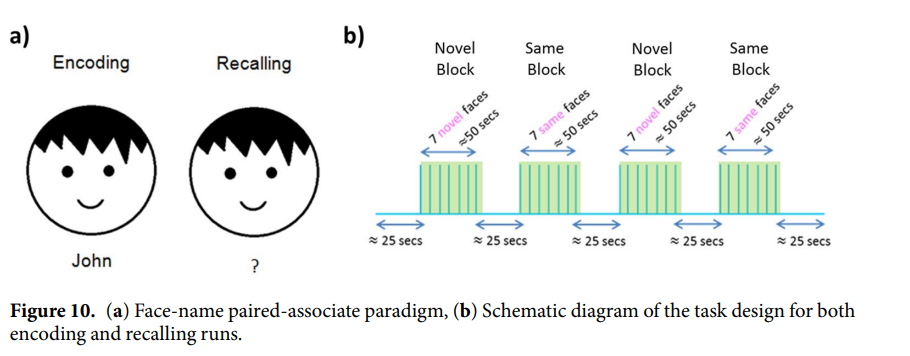Why we love blue hues on websites:a fNIRS investigation of color and its impact on the neural processing of ecommerce websites
Background Knowledge NIRS(Near Infrared Spectroscopy) : 근적외광(파장 ...
encoding : 인지과정 혹은 정보 처리 과정의 한 형태로, 청각, 시각, 촉각 등 감각을 통해 들어오는 정보를 처리하고 저장하기 위해 그 정보를 유의미하게 만들고, 장기기억에 저장되어 있는 기존의 정보와 연결하고 결합하는 과정
Episodic Memory : 자전적 사건들(시간, 장소, 감정, 지식)에 관한 기억으로 어느 특정시간과 장소에서 일어났던 과거의 개인적인 경험의 모음이라고 할 수 있다. Episodic Memory는 Semantic Memory와 대비되는데 Episodic Memory는 시간 및 장소와 관련하여 조직된 기억내용을 가리키고 Semantic Memory는 그것이 획득된 맥락 등을 가리킨다.
Prefrontal Cortex :


Prior studies suggest that especially Paired-Associate Learning(PAL) tasks may be useful in detecting the earliest memory impairment in Alzheimer’s Disease(AD).
Here, we investigated the utility of functional Near Infrared Spectroscopy in measuring brain activity from prefrontal, parietal and temporal cortices of healthy adults (n=19) during memory encoding and retrieval under a face-name paired-associate learning task.
Our fndings demonstrate that encoding of novel face-name pairs compared to baseline as well as compared to repeated face-name pairs resulted in signifcant activation in left dorsolateral prefrontal cortex while recalling resulted in activation in dorsolateral prefrontal cortex bilaterally. Moreover, brain response to recalling was signifcantly higher than encoding in medial, superior and middle frontal cortices for novel faces.
Overall, this study shows that fNIRS can reliably measure cortical brain activation during a face-name paired-associate learning task. Future work will include similar measurements in populations with progressing memory defcits.
정리 :
선행연구에 따르면 paired-associate learning tasks는 알츠하이머를 조기에 발견하는데 유용하다. 본 연구에서는 fNIRS의 활용성을 평가하기 위해 건강한 성인 19명을 대상으로 face-name paired-associate learning task를 진행했다. 실험이 진행되는 동안 PFC영역의 헤모글로빈이 측정되었고, 실험결과는 아래와 같다.
Early detection of Alzheimer’s disease (AD) is critical to facilitate timely intervention to attenuate or stop the progressive cognitive decline. Loss of memory for recently experienced events or the so-called “episodic memory” is the frst symptom of amnesia in patients with AD and thus a large number of studies have been conducted to investigate the underlying brain phsyiology. Remembering proper names, the paired-associate learning task (PAL), which requires the use of episodic
memory is the most common problem among elderly2, 10–15. Several studies suggested that the PAL task could be useful in early detection of memory impairment.In the PAL task, one item of a pair is used to cue recall of the other item
The PAL task is widely used for assessing memory performance in the young and elderly population as well as patients with Mild Cognitive Impairment (MCI) and Alzheimer’s Disease2, 11–13, 18–20. Specifc regions of the hippocampus and prefrontal cortices have been identifed as critical to the success of memory encoding in both young and healthy elderly subjects during a face-name PAL task2, 18. In particular, the dorsolateral and ventrolateral prefrontal cortex (DLPFC and VLPFC) have been shown to be associated with the encoding and recalling phase of face-name PAL task
Several fMRI studies have shown that left inferior frontal and superior temporal cortices are activated during encoding of novel faces, while frontal and parietal cortices are activated during the encoding of the same faces
정리 :
AD는 인지력 저하 약화를 위해 조기발견하는 것이 중요하다. 최근 경험된 사건에 대한 기억이 손실되는 것, 즉 “episodic memory” 상실은 AD의 첫 번째 증상인데 선행연구에 따르면 PAL과제는 episodic memory를 사용하게끔 하여 AD를 초기에 발견할 수 있도록 하는 유용한 과제이다. (PAL은 두 개 아이템이 쌍을 이루어 제공된 뒤, 몇초 후 하나의 아이템을 통해 나머지 하나를 recall하도록 한다)
PAL 과제는 AD뿐만 아니라 경도인지장애(Mild Cognitive Impairment;MCI) 와 젊은층과 노년층의 기억성능을 평가하는 데에도 널리 사용된다. 선행연구에 따르면 전전두엽피질(prefrontal cortex;PFC)영역 중 dorsolateral과 ventrolateral prefrontal cortex (DLPFC and VLPFC)이 PAL과제 내 encoding과 recalling과 연관이 있는 것으로 나타났다.
또한 fMRI 연구에 따르면 novel face를 encoding할 때에는 left inferior frontal과 superior temporal cortices가 활성화되고, same face를 encoding할 때에는 frontal과 parietal cortices이 활성화 되는 것으로 나타났다. ___

A face-name PAL task was used in this study that has previously been used in an fMRI study. The stimuli were presented using a personal computer. Each run consisted of two novel face-name pair blocks and two same face-name pair blocks, Each block lasted ~50 secs in which 7 face-name pairs were displayed sequentially. Faces were presented on a white background on the screen for 4.5 secs and there was a 3–3.5 sec interval between each face-name pair trial.
정리 :
실험은 두 개의 Run으로 구성됨 (encoding run / recalling run)
각각의 Run은 encoding - recalling - encoding - recalling순으로 총 두번씩 나타남
encoding : 얼굴-이름 쌍을 보여줌
recalling : 얼굴만 보여주고 이름을 맞추도록 함
각각의 Run은 두 개의 Block으로 구성됨 (novel face name pair block / same face name pair block)
각각의 Block은 novel - same - novel - same순으로 총 두번씩 나타남(상단 이미지 참고)
Each Block : 50초가량 진행 / 7개의 face-name pair 제공(4.5sec제공 - 3~3.5s Interval 반복)
Lukanov, K., Maior, H. A., & Wilson, M. L. (2016, May). Using fNIRS in usability testing: understanding the effect of web form layout on mental workload. In Proceedings of the 2016 CHI Conference on Human Factors in Computing Systems (pp. 4011-4016).
Avenco comes with a built-in contact form.

